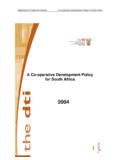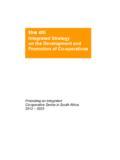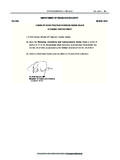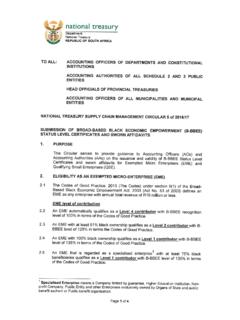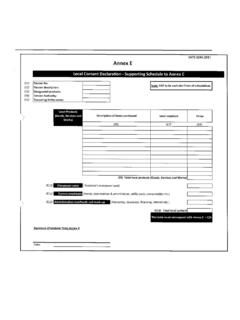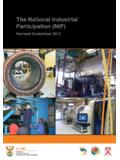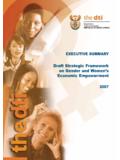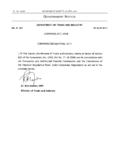Transcription of ANNUAL REVIEW OF SMALL BUSINESS IN SOUTH …
1 ANNUAL REVIEW OF SMALL BUSINESS IN SOUTH africa 2005-2007 FINAL DRAFT August 2008 Minister s foreword the dti, 2008 i MINISTER S FOREWORD It is with great pleasure that I present the ANNUAL REVIEW of SMALL BUSINESS in SOUTH africa (2006-2007) on behalf of the Department of Trade and Industry (the dti). The current edition marks the third time that the dti has co-ordinated the production of the REVIEW and, as before, contains a combination of primary research published here for the first time as well as a synthesis of information on SMMEs available in SOUTH africa .
2 The publication also draws out important issues and policy implications. The analysis highlights successes as well as areas where further work is needed. Overall, micro, very SMALL and SMALL businesses accounted for 27-34% of total GDP in 2006. This GDP share remained relatively constant across the period 2001-2006. In terms of officially registered SMMEs that are economically active, the sector grew by 27% between 2004 and 2007 (from 422 000 to 536 000). It is encouraging to note that the government s SMME support strategy, tabled in Cabinet in 2005 and which provided the backdrop at a policy level to this edition of the REVIEW , is starting to bear fruit.
3 However, against this should be weighed up the fact that the positive growth in economically active enterprises does not apply to all size categories micro enterprises showed a negative growth of between 2004 and 2007. As a result, the share of micro enterprises in the total pool of registered SMMEs in SOUTH africa significantly decreased, from 50% of SMMEs in 2004 to 37% in 2007. In relation to equity targets, progress has been made. An analysis of the demographics of SMME BUSINESS ownership indicates that in March 2007, Africans represented about 71% of the country s BUSINESS owners.
4 This is mainly in the formal sector however (an increase between March 2005 and March 2007 from 22% to 31%), with the figures for informal BUSINESS remaining more or less constant at 88%. Gains have also been made in respect of the participation of women in SMMEs - in March 2007, about 45% of women in SOUTH africa were owning and managing a BUSINESS (up from 24% in March 2005). As is the case with the figures for population group, in March 2007 the share of female BUSINESS owners was far higher in the informal sector (52%) than in the formal sector (31%).
5 Given the high number of people working in the informal sector and the potential of co-operatives and micro-enterprises to generate employment, it is imperative that further attention and resources should be focused on this area. ANNUAL REVIEW of SMALL Businesses in SOUTH africa the dti, 2008 ii The sustainability of SMMEs is also of concern: approximately 1% of enterprises registered between 1 April 2005 and 31 March 2006 lasted only between years. There has also been a steady increase in the number of liquidations, particularly in the following industrial sectors: wholesale and retail trade; catering and accommodation, financing, insurance, real estate and BUSINESS services (although the highest number of new registrations in a specific period is also found in these industrial sectors).
6 The literature indicates that despite significant progress in creating an enabling environment for SMMEs, much work remains, with a majority of enterprises remaining in the nascent and 'baby BUSINESS ' phases (less than years in existence). Research by the Global Entrepreneurship Monitor (GEM) confirms that the survival rate for start-ups in SOUTH africa is low and that the opportunity for entrepreneurial activity is the lowest of all the reviewed developing countries. Nonetheless, it is encouraging to note that Local Economic Development (LED) initiatives in the Provincial Focus section of this REVIEW (which looks at Kwa-Zulu Natal) are starting to make a real impact on economic development and SMME growth.
7 The two sector-specific analyses included in this REVIEW (SMMEs in Manufacturing; and SMMEs in Education and Training) also provide useful insights in relation to support programmes, highlighting the importance of sector-specific research and the design of customised support interventions to suit the specific needs of SMMEs in each sector. It is our sincere hope that the insights and ideas put forward in this REVIEW will contribute substantially towards our collective understanding of the current SMME profile in the country and how we can continue to enhance our support for the SMALL , Medium and Micro Enterprises across all forms of enterprises and a wide range of existing and new interventions.
8 Mr Mandisi Mpahlwa Minister of Trade and IndustryPreface the dti, 2008 iii PREFACE It is with great pleasure that the dti presents the ANNUAL REVIEW of SMALL BUSINESS in SOUTH africa for the period 2006-2007. In most data tables, baseline data for 2005 is included. This baseline data is largely sourced from the previous edition of this report, based on research performed by Trade and Industrial Policy Strategies (TIPS). The ANNUAL REVIEW has two main objectives: o to provide an updated qualitative and quantitative analysis on what is known about SMMEs in SOUTH africa for the use of all institutions and state organs that are involved in SMME support o to contribute to policy formulation on SMME support through adding to the body of reliable data on SMMEs.
9 As such, the final publication is of interest to a broad target audience: policy-makers; all those involved in SMME development and support (including government bodies, NGOs and the corporate sector); economists, researchers and investors and last but not least, SMMEs themselves. There is an additional process objective which should also be mentioned. Following the practice adopted by the TIPS research team who worked on the previous two ANNUAL Reviews, this year s REVIEW consciously endeavours to provide readers particularly researchers with a detailed understanding of the methodological principles and approaches that have shaped the report, as well as the databases used for the statistical analysis and some of the challenges and data limitations that were experienced (see Chapter 1).
10 It is recommended that this practice should continue, as it will contribute to the ongoing improvement of the REVIEW in future years. Traditionally the ANNUAL REVIEW of SMALL BUSINESS in SOUTH africa has two sections: a Regular Features section (the National profile) and a Non-Regular Features section (selected Focus Areas). This year s edition has adhered to this format, but presents the information in one volume instead of two for ease of reference. Part 1 (Regular Features National profile) begins with a discussion of the context of SMME development in SOUTH africa (Chapter 2), specifically what the literature has to say about the current economic environment and macro-economic outlook, the policy and regulatory environment and general trends and performance of SMMEs.
